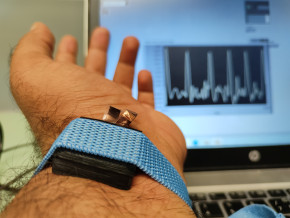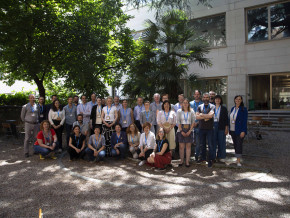Can behavioural economics help with the enforcement of social distancing?
People’s compliance with lockdown, social distancing instructions and other protective measures are influenced by their beliefs, expectations and concern for others. Insights from behavioural economics can help in the design of effective policies.
To mitigate the impact of the Covid-19 pandemic, it is necessary that people change their daily behaviour. This process can be helped using a variety of tools that go from fines in cases of non-compliance with lockdown measures to appeals by public authorities. To identify the policies that are most likely to work, standard economic analysis tells us that it is essential to understand people’s incentives, what they want to achieve and the constraints on their decisions and actions. The approach taken by behavioural economics is to recognise in addition the importance of cognitive limitations, so that, for example, biases can play an important role in decision-making.
Another characteristic of behavioural approaches is to emphasise the complexity of what motivates people to take a certain course of action. Going beyond narrow self-interest, altruism (‘pro-sociality’) and feelings of civic duty, for example, can be important motivational drivers in certain contexts, while spite and envy may prevail in others. Behavioural economics provides additional insights into how to enforce social distancing. A series of studies show the importance of beliefs and expectations in shaping people’s social distancing behaviour: fatalism is detrimental, while policies that are less severe than expected help with compliance. Altruism also matters and can be leveraged to improve social distancing behaviour, as does the degree of trust that prevails within communities.
Behavioural economics emphasises the importance of expectations and beliefs
The pandemic has been characterised by a high degree of uncertainty, concerning both medical aspects, such as the mortality associated with Covid-19, as well as the effectiveness of the policy responses. This has made the decision processes of policy-makers particularly difficult. But it also has potential implications for individual behaviour, as people’s beliefs may influence the degree to which they comply with social distancing measures.
Beliefs about infectiousness affect social distancing in surprising ways
An experiment with 3,610 UK and US participants reveals the importance of this aspect of beliefs about infectiousness (Akesson et al, 2020). To start with, participants tend to overestimate vastly how many other people will be infected by one person (what is known as the R number – which when exactly one, each sick person infects one other and the number of Covid-19 cases is constant over time). When provided with expert information, people partially correct their beliefs about the virus.
In the experiment, beliefs are manipulated, as some participants are provided with an upper bound expert estimate (one person will infect on average five people), while others are provided with a lower bound estimate (two people). Afterwards, participants are asked about their willingness to comply with social distancing measures. What emerges is that people who are led to believe that the virus is more infectious are actually less willing to take social distancing measures. This is an instance of fatalism and its effects are confirmed in another online experiment (Hayes, 2020), where participants based in the United States read a short message about the pandemic.
One group reads a message with a fatalistic tone, underlining how social distancing is only a temporary fix; while another group reads a message with an optimistic one, indicating how social distancing is effective in buying time before we can develop a vaccine. Participants exposed to the fatalistic message display lower intentions to comply with social distancing measures and lower support for policy measures implementing social distancing. These results point to the risks associated with overly negative reporting about the pandemic, as people can be discouraged in taking action to mitigate the risks.

Compliance with social distancing also depends on how long people expect measures to last: this is important for policy design
More directly related to the design of policies, compliance with social distancing measures may depend on how long people expect them to last. If this is indeed the case, policy-makers can take action to influence perceptions in a desired direction. For example, when announcing the UK’s lockdown on 23 March, prime minister Boris Johnson said that the restrictions would be in place for at least three weeks and would be kept under constant review. Announcing a short duration may increase people’s willingness to comply, as the costs associated with isolating for a few weeks are much smaller than doing it for months in a row, and imposing a difficult-to-reach goal may discourage people from making the effort. On the other hand, announcing short durations makes it more likely that the measures need to be prolonged and people may react very badly to extensions, thus reducing their willingness to comply at a later stage.
One study in Italy (Briscese et al, 2020) investigates these issues using repeated surveys of representative samples of the Italian population. Italy was the first European country to impose a lockdown, establishing it on 8 March, initially until 3 April, but then extending it twice, first to 13 April and then to 4 May, with several measures (for example, school closures) extended even further. Beliefs about the duration of ‘stay-at-home’ measures changed a lot over this period. In mid-March, when contagion was rising rapidly, very few people expected lockdown to end on the announced date, and many considered long extensions the most likely scenario. In contrast, in the second week of April, right after the peak of the epidemic in Italy, beliefs were more optimistic, with most respondents expecting the measures to last only a few extra weeks. At the end of April, when the epidemic was already in its descending phase, expectations shortened further. Most importantly, when facing scenarios for extensions of different duration, people who received a ‘positive surprise’ – that is, a potential extension shorter than what they expected – were more likely to increase their willingness to comply with isolation measures, whereas those facing an extension longer than expected were less willing to maintain or increase their self-isolation efforts.
This study also looks at beliefs about how long most people would be able to maintain self-isolation and asked the same about the respondents themselves. Slowing down the circulation of the virus depends on social isolation efforts by everybody and the belief that others will not comply may induce people to give up too. The study shows how a sizable share of the population (about 40%) feel able to keep self-isolation for extended periods of time, whereas a much smaller share (slightly less than 15%) believe that this is the case for other people. The emphasis in the media on isolated instances of non-compliance (as anecdotally observed in Italy) might have contributed to spreading these beliefs, thereby actually reducing compliance. These results show how in designing policies to enforce social distancing, policy-makers should pay close attention to how they are communicated to the public as this could affect beliefs. Communication can also affect motivation – for example, appealing to people’s ‘pro-social’ or altruistic attitudes.
People who are more pro-social are typically more compliant with social distancing; observing pro-social role models can also have an effect
Social distancing has an impact on the health of others. This means that people’s altruism and pro-social attitudes could play an important role in whether and how they comply. A study of a representative sample of the Swedish population (Campos-Mercade et al, 2020) finds that people who are more pro-social are more likely to behave in ways that are important to reduce the spread of Covid-19 (for example, self-isolating if they show symptoms). They are also more likely to buy a cloth face mask or donate to a solidarity response fund by the World Health Organization and UNICEF. In the study, pro-sociality is measured a week after the health behaviour survey through a separate survey in which people can decide how to allocate actual money between themselves and others. Strikingly, a similar measure taken two years earlier also predicts health behaviour during the pandemic, showing the persistence of this personality trait.
This does not mean, however, that pro-social behaviour cannot change with circumstances. An online experiment with 690 US-based participants (Abel, 2020) measures pro-sociality through donations to the Centers for Disease Control and Prevention emergency response fund with the purpose of buying personal protective equipment and critical response supplies. The study finds that participants who watch a one-minute news item showing positive citizen role models (healthcare workers coming out of retirement to treat the sick) are more likely to donate compared with participants watching negative role models (people ignoring social distancing during Spring break). The opposite is true for public role models, where donations are higher after watching negative news (senators selling stocks before the coronavirus crash) compared with a positive one (an inspirational speech by a state governor).
Levels of trust and civic capital also matter for compliance
The fact that positive citizen role models trigger an increase in pro-sociality is linked to the importance of trust in coordinating cooperation when, as in the case of social distancing, people’s actions are strongly interrelated to each other. There is already a body of evidence linking compliance with social distancing, in terms of reduced mobility, to trust or, more generally, to ‘civic capital’. In particular, the evidence so far shows how. In concomitance with the pandemic, there is a stronger decrease in mobility near retail and recreation outlets (for example, restaurants, shopping centres, and cinemas) and a stronger increase in time spent in residential areas in US counties and European regions characterized by higher civic capital (Barrios et al, 2020). Civic capital is measured through electoral participation, a composite index of pro-social behaviour or survey responses to questions on trust. Mobility is measured through Google Community Mobility Reports, based on the location history of Google account holders. Mobility between January and May 2020, measured through phone location tracking records, declined significantly more in Italian provinces with higher civic capital, measured through blood donations, a survey-based measure of trust in others, and a measure of newspaper readership (Durante et al, 2020).
The same is true for German districts. Once a lockdown policy is implemented, mobility measured through mobile phone data decreases more in US counties with relatively more trust in others, with a particularly important role for trust in the press (Brodeur et al, 2020). The effects of trust on mobility become stronger with the degree of stringency of lockdown measures in European regions (Bargain et al, 2020). This means that the gap between high- and low-trust regions increases as governments adopt stricter measures to tackle the pandemic. The stringency of measures is based on the Oxford Covid-19 Government Response Tracker.
These studies show correlations between mobility and measures of civic capital or trust. As such, they do not necessarily imply a causal link between the two variables. The fact that this relationship appears in different countries, at different levels of geographical disaggregation (regions, provinces, counties) suggests, however, that trust may indeed be instrumental in increasing social distancing and that measures aimed at increasing trust may be part of a toolkit to boost the efficacy of social distancing measures.
To conclude, the essential message emerging from the existing behavioural economics research on the pandemic is that perceptions and motivation matter. As a consequence, they should be taken into consideration when designing policies.
Author: Mirco Tonin
Image: unsplash.com
Related Articles

Tecno-prodotti. Creati nuovi sensori triboelettrici nel laboratorio di sensoristica al NOI Techpark
I wearable sono dispositivi ormai imprescindibili nel settore sanitario e sportivo: un mercato in crescita a livello globale che ha bisogno di fonti di energia alternative e sensori affidabili, economici e sostenibili. Il laboratorio Sensing Technologies Lab della Libera Università di Bolzano (unibz) al Parco Tecnologico NOI Techpark ha realizzato un prototipo di dispositivo indossabile autoalimentato che soddisfa tutti questi requisiti. Un progetto nato grazie alla collaborazione con il Center for Sensing Solutions di Eurac Research e l’Advanced Technology Institute dell’Università del Surrey.

unibz forscht an technologischen Lösungen zur Erhaltung des Permafrostes in den Dolomiten
Wie kann brüchig gewordener Boden in den Dolomiten gekühlt und damit gesichert werden? Am Samstag, den 9. September fand in Cortina d'Ampezzo an der Bergstation der Sesselbahn Pian Ra Valles Bus Tofana die Präsentation des Projekts „Rescue Permafrost " statt. Ein Projekt, das in Zusammenarbeit mit Fachleuten für nachhaltiges Design, darunter einem Forschungsteam für Umweltphysik der unibz, entwickelt wurde. Das gemeinsame Ziel: das gefährliche Auftauen des Permafrosts zu verhindern, ein Phänomen, das aufgrund des globalen Klimawandels immer öfter auftritt. Die Freie Universität Bozen hat nun im Rahmen des Forschungsprojekts eine erste dynamische Analyse der Auswirkungen einer technologischen Lösung zur Kühlung der Bodentemperatur durchgeführt.

Gesunde Böden dank Partizipation der Bevölkerung: unibz koordiniert Citizen-Science-Projekt ECHO
Die Citizen-Science-Initiative „ECHO - Engaging Citizens in soil science: the road to Healthier Soils" zielt darauf ab, das Wissen und das Bewusstsein der EU-Bürger:innen für die Bodengesundheit über deren aktive Einbeziehung in das Projekt zu verbessern. Mit 16 Teilnehmern aus ganz Europa - 10 führenden Universitäten und Forschungszentren, 4 KMU und 2 Stiftungen - wird ECHO 16.500 Standorte in verschiedenen klimatischen und biogeografischen Regionen bewerten, um seine ehrgeizigen Ziele zu erreichen.

Erstversorgung: Drohnen machen den Unterschied
Die Ergebnisse einer Studie von Eurac Research und der Bergrettung Südtirol liegen vor.
